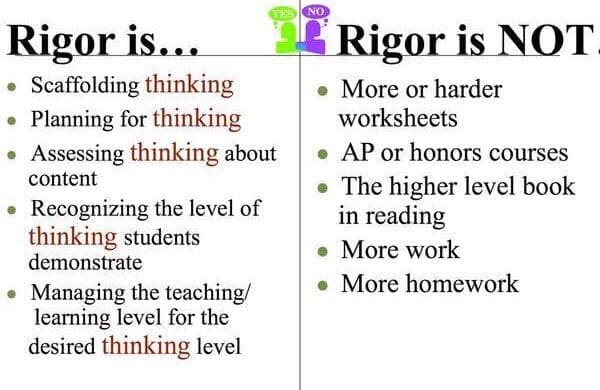What is Rigor?

Making Rigor Relatable to Students by Michael McDowell defines rigor as the balance of surface, deep, and transfer learning. That is, rigor is about ensuring that students learn ideas, combine ideas to form bigger ideas, and apply those ideas.
Importance of Academic Rigor
Academic rigor is a great way to teach, because it helps kids think deeply, find value in their own lives, and become aware of how they learn. So, kids learn a skill that can help them do well in school and love learning for a long time. This is according to Academic rigor — and why it’s so important for your child article.
Two Key Components
My Two Key Components in Path to Rigor post says the Path to Rigor has two components-complexity and autonomy. This is according to authors Carla Moore, Michael D Toth, and Robert J Marzano, The Essentials for Standards-Driven Classrooms.
Complexity, authors define, is the cognitive load required by the standard. There are four levels in Marzano’s taxonomy: Retrieval, comprehension, analysis, and knowledge utilization.
Fast forward to the present, The ABCs of Rigorous Lesson Design article by Karin Hess has a new way of looking at rigor through depth of knowledge levels.
Since many of you have taken interest in my Two Key Components Path to Rigor post, I would like to follow up with a more in-depth look on this subject.
Depth of Knowledge (DOK)
I am sure many of you have heard of Norman Webb’s Depth of Knowledge Framework (2002). Hess suggests thinking about how to change the roles of teachers and students. This is the most important thing you can do with Depth of Knowledge levels. In Levels 1 and 2, teachers guide students’ learning, and use “near or familiar transfer” to learn and remember things. To get to Levels 3 and 4, teachers guide students’ learning, while “far transfer” lets students choose how they want to learn. When you’re planning a lesson, you should think about how to get to Depth of Knowledge Level 3 or Level 4.
Hess explains that some teachers think that rigor means giving students more work to do, asking them to remember harder or more abstract ideas, or letting them work alone on hard tasks. Many students need a more structured way to learn.
Hess says cognitive rigor is affected by more than how hard the material is. It’s also affected by how engaged students are with it (also called depth of knowledge levels) and how big the learning task they want to do. Cognitive rigor is shown when students can think differently, improve their thinking based on what others say, use smart scaffolding and teamwork, or use self-direction and metacognitive skills.
How do you get students to Depth of Knowledge level 3 or level 4? According to Eileen Depkato, author of Raising Rigor, the key is to use Bloom’s taxonomy, which can help teachers come up with questions that make students think more deeply, while also giving them the right amount of knowledge at the right time. An important part of planning a lesson or unit is coming up with the questions teachers will use to teach and test students. For example, using Bloom’s taxonomy, the three steps below show how to find questions.
- Identify the standards and the content to teach.
- Determine what students need to know and do according to the standards.
- Identify the questions to ask to ensure students gain the desired knowledge and skills.
| Standards | Identify the theme of a story, providing insights and specific examples from the text. |
| Lesson Targets | 1. Students will know details in a story and be able to communicate how events impact the story.2. Students will be able to identify the theme and support their beliefs with evidence from the story. |
| Question Design | Who were the main characters in the story? Creating Evaluating Analyzing Where did the story mostly take place? Applying Understanding When did the story take place? Remembering (Check this box) |
Depkato notes these steps do not complete the lesson-design process, because Bloom’s Taxonomy helps teachers make questions that help students learn what they need to learn. Another important point to remember is to keep students thinking, make sure there is a mix between questions that build on what they already know, and questions that go further and use what they’ve learned. Some standards might not need questions at all levels of taxonomy.
So, when teachers use Bloom’s Taxonomy, it promotes higher-order thinking. It is important to note the difference Bloom’s Taxonomy helps teachers design questions at increased levels of sophistication. Webb’s Depth of Knowledge is a tool for evaluating cognitive complexity required by a standard, and for evaluating existing questions to determine the rigor required to respond to them.
Connecting Webb’s Depth of Knowledge Framework to Higher-Order Thinking Skills
Depth of Knowledge provides a framework for viewing standards and assessment items according to their cognitive complexity. Complexity and difficulty are two different things, as Webb points out. An item can be difficult without being complex. See a sample task at increase levels of complexity below:
| DOK Level | English Language Arts Example |
| Level 1: Recall and Reproduction | Who is the main character in the story? |
| Level 2: Skills and Concepts | Identify the theme in the story. Provide evidence from the story to support the theme you have chosen. |
| Level 3: Strategic Thinking | Compare the Wicked Witch from The Wonderful Wizard of OZ to the Queen of Hearts in Alice’s Adventures in Wonderland. How are they similar and how are they different? Provide evidence. |
| Level 4: Extended Thinking | Read two different stories by the same author. Describe similarities and differences in the writing style of the author. |
Explore Rigor By Design Blog Posts

Rigor By Design Moves
Seven Misconceptions of Depth of Knowledge and Rigor

